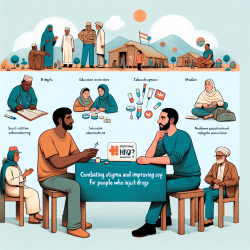Introduction
The recent study titled "PrEP Care Continuum Engagement Among Persons Who Inject Drugs: Rural and Urban Differences in Stigma and Social Infrastructure" provides valuable insights into the barriers and facilitators of pre-exposure prophylaxis (PrEP) uptake among persons who inject drugs (PWID). This research highlights the significant role that stigma and social infrastructure play in PrEP engagement, particularly in rural versus urban settings. For practitioners working with PWID, understanding these dynamics is crucial for improving PrEP uptake and, consequently, HIV prevention efforts.
Key Findings
The study identified several key differences between rural and urban settings in terms of PrEP awareness, knowledge, willingness, and uptake among PWID:
- Awareness and Knowledge: Urban participants demonstrated higher awareness and knowledge of PrEP, largely due to the presence of syringe service programs (SSPs) that fostered information sharing and community building.
- Stigma: Stigma related to drug use, HIV, and sexualities was a significant barrier, especially in rural areas where social networks are tighter, and stigma is more pervasive.
- Social Infrastructure: Urban SSPs served as vital social infrastructures that mitigated stigma and facilitated PrEP awareness and engagement.
Implications for Practitioners
Practitioners can leverage these findings to enhance their strategies for PrEP engagement among PWID:
- Enhance Awareness Campaigns: Tailor awareness campaigns to include drug use behaviors, not just sexual transmission, to better reach PWID.
- Leverage Social Infrastructure: Utilize SSPs as key sites for disseminating PrEP information and services, especially in urban settings.
- Address Stigma: Develop interventions that directly address and reduce stigma associated with drug use and HIV, particularly in rural areas.
- Consider Mobile Solutions: For rural areas, consider mobile SSPs that can bring services and information directly to PWID, reducing transportation barriers.
Encouraging Further Research
While this study provides a foundational understanding of the barriers and facilitators to PrEP engagement among PWID, further research is needed to explore:
- The effectiveness of different stigma-reduction interventions in both rural and urban settings.
- The potential of injectable PrEP as a more discreet and easier-to-maintain option for PWID.
- The role of policy and funding in supporting SSPs as social infrastructures for PrEP dissemination.
To read the original research paper, please follow this link: PrEP Care Continuum Engagement Among Persons Who Inject Drugs: Rural and Urban Differences in Stigma and Social Infrastructure.










